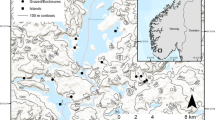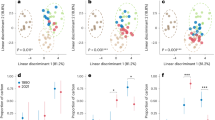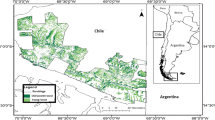Abstract
A high proportion of the global soil carbon stock is stored in tundra soils. However, populations of arctic-breeding migratory geese including pink-footed geese, Anser brachyrhynchus, are increasing due to agricultural changes and conservation measures in their wintering grounds. Foraging by these geese, which is widespread in extent, reduces the quantity of carbon stored in arctic tundra ecosystems. Here, the potential carbon loss caused by foraging pink-footed geese is modelled across the high-arctic archipelago of Svalbard, combining field experiments, habitat maps and published spatial models of foraging. The carbon loss caused by foraging geese was estimated three growing seasons following perturbation allowing for some recovery to take place. The carbon loss caused by 1-year worth of grubbing was estimated to be 1,700 tonnes, or 37 kg per goose. A total of over 340,000 tonnes of carbon could be affected given an unlimited increase in goose population. Estimated losses were mostly from wetter habitats, which are both carbon rich and highly selected for by foraging geese. The across-landscape carbon loss caused by geese is not great in magnitude in comparison to expected climate-driven carbon losses; however, it is locally severe, and demonstrates how migratory connectivity links processes, such as agricultural change and conservation measures in temperate Europe with carbon dynamics in the high arctic.

Similar content being viewed by others
References
Abraham KF, Jefferies RL, Rockwell RF (2005) Goose-induced changes in vegetation and land cover between 1976 and 1997 in an arctic coastal marsh. Arct Antarct Alp Res 37:269–275
Bellamy PH, Loveland PJ, Bradley RI, Lark RM, Kirk GJD (2005) Carbon losses from all soils across England and Wales 1978–2003. Nature 437:245–248
Callaghan TV, Bjorn LO, Chernov Y, Chapin T, Christensen TR, Huntley B, Ims RA, Johansson M, Jolly D, Jonasson S, Matveyeva N, Panikov N, Oechel W, Shaver G, Henttonen H (2004) Effects on the structure of arctic ecosystems in the short- and long-term perspectives. Ambio 33:436–447
Christensen TR, Johansson T, Olsrud M, Strom L, Lindroth A, Mastepanov M, Malmer N, Friborg T, Crill P, Callaghan TV (2007) A catchment-scale carbon and greenhouse gas budget of a subarctic landscape. Philos Trans Soc A 365:1643–1656. doi:10.1098/rsta.2007.0235
Elberling B (2007) Annual soil CO2 effluxes in the high arctic: the role of snow thickness and vegetation type. Soil Biol Biochem 39:646–654. doi:10.1016/j.soilbio.2006.09.017
Esselink P, Helder GJF, Aerts BA, Gerdes K (1997) The impact of grubbing by Greylag Geese (Anser anser) on the vegetation dynamics of a tidal marsh. Aquat Bot 55:261–279
Fox AD, Madsen J, Boyd H, Kuijken E, Norriss DW, Tombre IM, Stroud DA (2005) Effects of agricultural change on abundance, fitness components and distribution of two arctic-nesting goose populations. Glob Change Biol 11:881–893
Fox TA, Francis IS, Bergersen E (2006) Diet and habitat use of Svalbard pink-footed geese Anser brachyrhynchus during arrival and pre-breeding periods in Adventdalen. Ardea 94:691–699
Gauthier G, Giroux JF, Reed A, Bechet A, Belanger L (2005) Interactions between land use, habitat use, and population increase in greater snow geese: what are the consequences for natural wetlands? Glob Change Biol 11:856–868
Goni MA, Yunker MB, Macdonald RW, Eglinton TI (2005) The supply and preservation of ancient and modem components of organic carbon in the Canadian Beaufort Shelf of the Arctic Ocean. Mar Chem 93:53–73. doi:10.1016/j.marchem.2004.08.001
Hobbie SE, Schimel JP, Trumbore SE, Randerson JR (2000) Controls over carbon storage and turnover in high-latitude soils. Glob Change Biol 6:196–210
Jefferies RL, Jano AP, Abraham KF (2006) A biotic agent promotes large-scale catastrophic change in the coastal marshes of Hudson Bay. J Ecol 94:234–242
Jensen RA, Madsen J, O’Connell M, Wisz MS, Tømmervik H, Mehlum F (2008) Prediction of the distribution of arctic-nesting pink-footed geese under a warmer climate scenario. Glob Change Biol 14:1–10
Lal R (2003) Soil erosion and the global carbon budget. Environ Int 29:437–450. doi:10.1016/S0160-4120(02)00192-7
Myres W, Shelton R (1998) Survey methods for ecosystem management. Wiley-Interscience, New York
Olofsson J, Stark S, Oksanen L (2004) Reindeer influence on ecosystem processes in the tundra. Oikos 105:386–396
Post WM, Emanuel WR, Zinke PJ, Stangenberger AG (1982) Soil carbon pools and world life zones. Nature 298:156–159
Sjögersten S, Van der Wal R, Woodin SJ (2006) Small-scale hydrological variation determines landscape CO2 fluxes in the high arctic. Biogeochemistry 80:205–216
Sjögersten S, Van der Wal R, Woodin SJ (2008) Habitat type determines herbivory controls over CO2 fluxes in a warmer arctic. Ecology 89:2103–2116
Smith P (2005) An overview of the permanence of soil organic carbon stocks: Influence of direct human-induced, indirect and natural effects. Eur J Soil Sci 56:673–680. doi:10.1111/j.1365-2389.2005.00708.x
Soegaard H, Nordstroem C (1999) Carbon dioxide exchange in a high-arctic fen estimated by eddy covariance measurements and modelling. Glob Change Biol 5:547–562
Soegaard H, Nordstroem C, Friborg T, Hansen BU, Christensen TR, Bay C (2000) Trace gas exchange in a high-arctic valley 3. Integrating and scaling CO2 fluxes from canopy to landscape using flux data, footprint modeling, and remote sensing. Glob Biogeochem Cycles 14:725–744
Speed JDM (2009) Ecosystem engineers of the tundra: the impacts and extent of goose herbivory in the high arctic. PhD Thesis, University of Aberdeen, UK
Speed JDM, Woodin SJ, Tømmervik H, Tamstorf MP, Van der Wal R (2009) Predicting habitat utilization and extent of ecosystem disturbance by an increasing herbivore population. Ecosystems 12:349–359
Stark S, Grellmann D (2002) Soil microbial responses to herbivory in an arctic tundra heath at two levels of nutrient availability. Ecology 83:2736–2744
Van der Wal R (2006) Do herbivores cause habitat degradation or vegetation state transition? Evidence from the tundra. Oikos 114:177–186
Van der Wal R, Sjögersten S, Woodin SJ, Cooper EJ, Jonsdottir IS, Kuijper D, Fox TAD, Huiskes AD (2007) Spring feeding by pink-footed geese reduces carbon stocks and sink strength in tundra ecosystems. Glob Change Biol 13:539–545
Zonneveld IS, Lebouille M, de Nies N (2005). Landscape ecology (‘land unit’) map of Edgeøya, Spitsbergen with emphasis on vegetation. In: Boschman N, Hacquebord L (eds) Permanence in diversity. Netherlands ecological research on Edgeøya, Spitsbergen. Circumpolar studies, vol 1. Arctic Centre, University of Groningen, Netherlands
Acknowledgments
Many thanks are due to Adam Bratt, Jonathan McAllister for field assistance, Graeme Abel for field assistance and sample processing and the UNIS logistic department for field support and safety training. The authors are grateful to the Sysselmannen of Svalbard for permission for field experiments in Adventdalen. Jesper Madsen and two anonymous reviewers provided comments which greatly benefited the development of this manuscript. Funding was provided by the Natural Environment Research Council (NER/S/A/2005/13880).
Author information
Authors and Affiliations
Corresponding author
Rights and permissions
About this article
Cite this article
Speed, J.D.M., Woodin, S.J., Tømmervik, H. et al. Extrapolating herbivore-induced carbon loss across an arctic landscape. Polar Biol 33, 789–797 (2010). https://doi.org/10.1007/s00300-009-0756-5
Received:
Revised:
Accepted:
Published:
Issue Date:
DOI: https://doi.org/10.1007/s00300-009-0756-5




